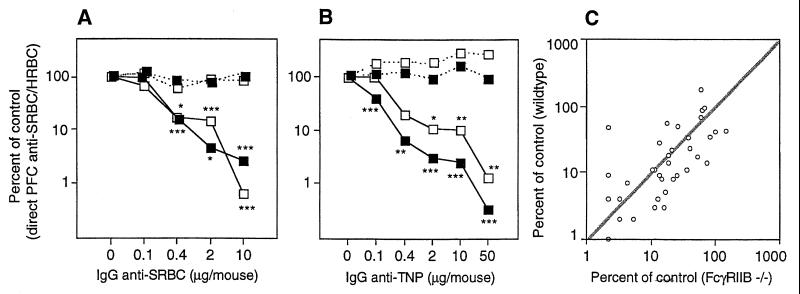Figure 1.
(A) Groups of six to nine FcγRIIB−/− (open symbols) or five to seven (C57BL/6 × 129/Sv)F1 (solid symbols) mice were immunized with 0–10 μg of polyclonal IgG anti-SRBC followed within 1 hr by 1 × 107 SRBC and 4 × 105 HRBC. Five days later the direct SRBC-specific (solid line) and HRBC-specific (broken line) PFC/spleen were assayed. The response is shown as the percentage of the response in control groups. PFC/spleen in the respective control groups (receiving antigen alone) were: FcγRIIB−/−, 106,615 SRBC, 21,183 HRBC; (C57BL/6 × 129/Sv)F1, 120,666 SRBC, 37,583 HRBC. (B) Groups of five FcγRIIB−/− or four to five C57BL/6 mice were immunized with 4 × 106 SRBC-TNP and 8 × 105 HRBC preincubated with 0–50 μg of a mixture of equal amounts of monoclonal IgG1 (H5), IgG2a (7B4), and IgG2b (1B4) anti-TNP. Symbols and assay are as in A. PFC/spleen in the respective control groups (receiving antigen alone) were: FcγRIIB−/−, 127,231 SRBC, 83,472 HRBC; C57BL/6, 35,080 SRBC, 34,260 HRBC. (C) Summary of the 14 experiments performed in which FcγRIIB−/− and wild-type control mice were immunized with polyclonal IgG anti-SRBC, monoclonal IgG1, IgG2a, or IgG2b anti-TNP, or mixtures of the mAbs. The suppression of direct PFC anti-SRBC (expressed as percentage of control response + 1) in FcγRIIB−/− mice is plotted vs. the suppression in corresponding wild-type mice (46 matched pairs; overlapping points are shown only as one symbol). A line with slope 1:1 is added to the figure for comparison.

